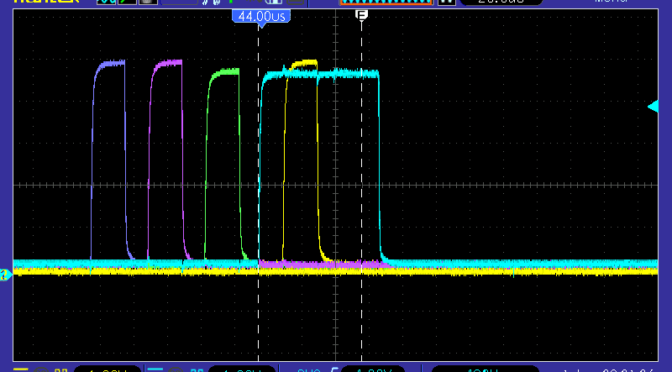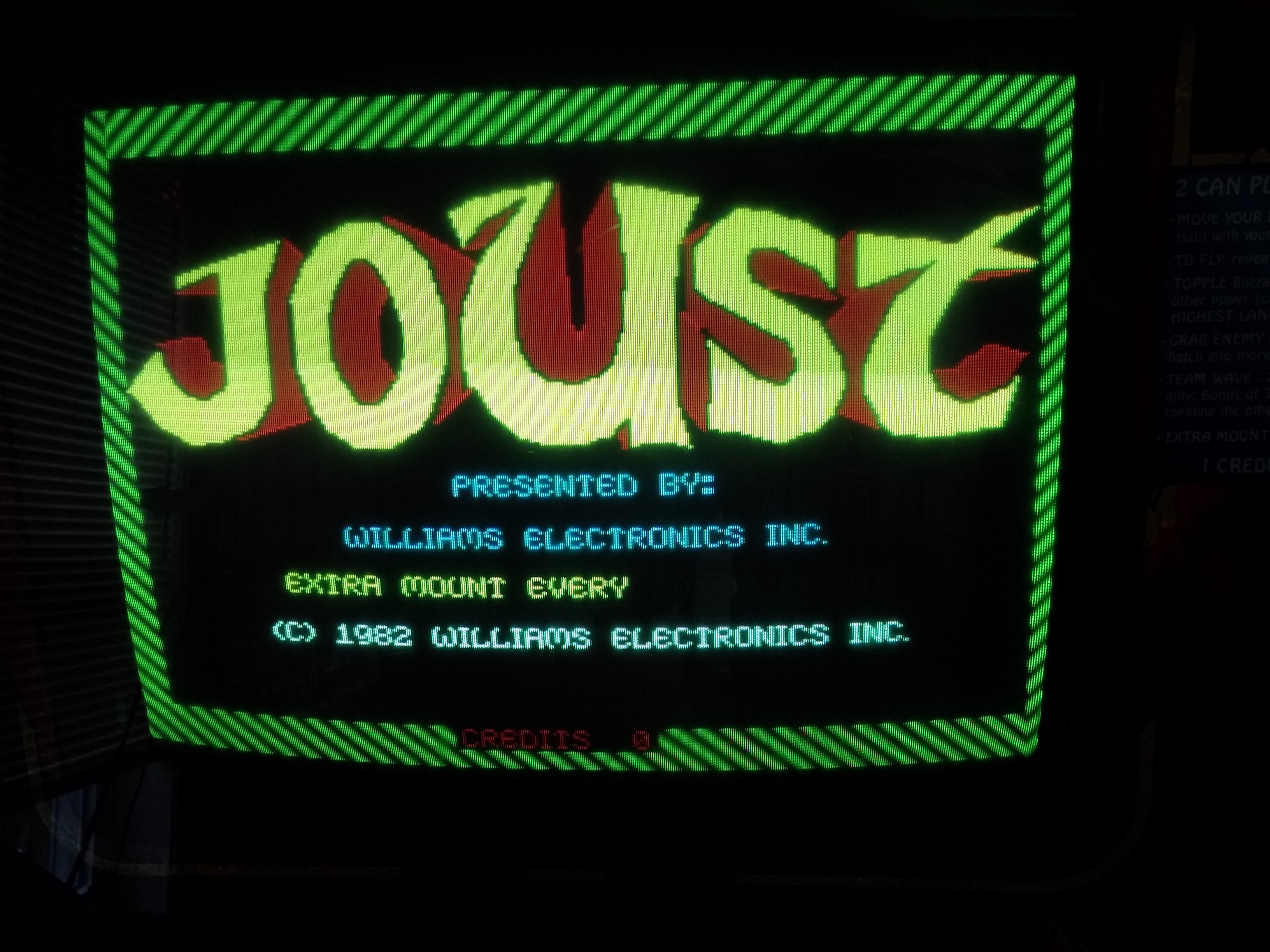I am seeing something across multiple classic Bally pins that makes me think it is an actual bug in the firmware. It has to do with the LATCH signals for the displays. Specifically the Credit/Match/Ball (CMB) display.
Tag Archives: arcade
Galaga Board with Enhancement Pack not Booting
I finally got around to working on a Galaga board for AM and I got it up and running and was leaving it on for a 24-hour test when it crapped out showing a error on ROM 39 (which does not exist). This eventually degraded into a state where it did not display any errors at all, and just seem to hang up at the nonvolatile memory test (NVM OK), and started playing random sounds.
Continue reading Galaga Board with Enhancement Pack not Booting
Theory of Operation of the Shaq 27722-1 (A23) LED Display Board
Theory of Operation of the Shaq 27722-1 (A23) LED Display Board (4-player score board).Theory of Operation of the Shaq 27722-1 (A23) LED Display Board (4-player score board).
Theory of Operation
This is a brief technical introduction to the operation of the 27722-1 (A23) board. It will cover inputs and behavior of the board.
Inputs
This board accepts the following three control inputs:
- Master Reset (/MR)
- 8-Bit Data (DX0–DX7 – pulled up to +5v/VCC)
- Enable/Strobe for the latches (AX4)
It also accepts +5, common GND, +12 and the +12V GND (both GNDs are connected together).
The incoming 8-bit data is split into two 4-bit words with the low word (DX0–DX3) used for specifying the value to display on a particular LED digit via the ‘4511 (BCD to 7-segment latch/decoder/driver), with DX0, DX1, DX2 and DX3 connected to inputs A, B, C and D (or D1, D2, D3, and D4), respectively. The high word (DX4–DX7) is used for digit selection via the ‘4514 (4 to 16-Line Latch/Decoder/Demultiplexer), with DX4, DX5, DX6 and DX7 connected to inputs A, B, C and D, respectively.
Latches for the corresponding chips are controlled via the AX4 signal, which is directly connected to the 4511’s /LE input and also goes through an inverter whose output is connected to the 4514’s LE.
The /MR signal is connected to the 4511’s /BI signal, which is used to blank the displays whenever the game is in reset.
Continue reading Theory of Operation of the Shaq 27722-1 (A23) LED Display Board
Spies Cross Reference List
There is an old cross reference list archived on Spies and replicated by a few arcade-related sites. I took this list and reformatted it, removed empty entries and made some items clickable for easy searching.
Words to Watch Out For When Buying Arcade Games or Pinball Machines
I have learned through many years of posts, sales, people, auctions, and similar experiences that there are certain words and phrases that you need to watch out for when buying games, boards, etc.
Untested
The first one, and it is a biggie – UNTESTED. Here is the truth: if dealing with a whole game, and it has an intact power cord, it is never “untested” – somebody tried to plug it in and power it on, guaranteed. When dealing with intact games, presume “untested” means “I plugged it in, it did not work” – in other words, “broken.”
Now, sometimes “untested” really does mean untested. For example, if someone just got a great bulk deal on a bunch of boards, and want to move them quickly, they may not want to go through the time and effort of testing each one. For example, it is not worth building an adapter for a board that sells for $50 working when I can sell it for $30 untested – I would spend more than $20 of my time and materials building that adapter.
Things like power supplies may legitimately be untested because they might not want to risk damaging a board because of a bad power supply (not everyone has a rig to properly test supplies under load). Same goes for controls, coin mechs, etc. Might not be worth the time to connect and try out each one.
In general, just presume that Untested means the same as Broken. That way, you are never disappointed.
Worked [time] ago when I put it into storage, on the shelf, etc.
This is another one. “It worked 6 months ago when I put it into storage,” or “it last worked two years ago before I put it on the shelf.” Same as above – play it safe and consider that to mean untested or just broken.
It Just Needs This One Inexpensive Part…
This is another favorite of mine. “It is broken and I am selling it for $100. It just needs this one little inexpensive $30 part and then it will be worth $400, so this is a great deal!” Continue reading Words to Watch Out For When Buying Arcade Games or Pinball Machines
Dead Gorf
So I found a dead Gorf on Craigslist. It was an older ad, but was still available when I inquired. Dude I picked it up from had done some pretty impressive restorations on some other games.
Anyway – it was dead alright. Shows a blank screen that looked overly blue due to how the monitor was adjusted, no starfield was visible. Slid the test switch over and power-cycled, but this made no difference either.
The previous owner had mentioned that he had done some work on it. I saw some of his other previous work on other boards of his and while not perfect (some cold joints, or not enough solder in some places leaving “pits”), it was not horrible and definitely no worse than what I was doing when I started out.
Anyhoo, starting with the power PCB – the previous owner said he had already replaced the caps, but I wanted a second look at it, JIC. On the solder side of the board, some larger traces has been lifted off the board during some previous repair work (I do not think it was his, maybe someone before him?).
It looked like the someone used a serious soldering gun to do the work, because there were scorch marks on the board(!) and flux was all over the older work too. Continuity was where it was supposed to be, so I guess that while it was ugly, it worked. Continue reading Dead Gorf
Bringing Joust Back to Life
So it came to pass that I ended up with three cabinets for $100 each. A Great Golf in a Midway cabaret, some Toaplan run-n-gun in a Taito Qix cabinet, and… A Joust(!) in its original cabinet.
I agreed to purchase all three sight-unseen. When I get them all home, the golf game worked except for a rolling screen, the run-n-gun has an board issue where some sprites are being displayed at the wrong horizontal locations, and the Joust?
Well, the Joust was dead. Simple static video (monitor needs a cap kit, too), watchdog barking, no response to inputs, nothing on the LED on the ROM board.
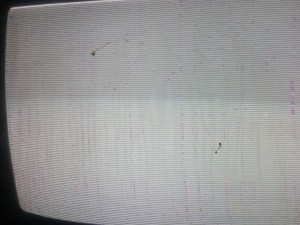
Joust Showing 1 3 5 and a REALLY Effed-Up Screen
[This was extracted from a large article about getting a dead Joust operational. I thought it made sense to put this part in its own post to help anyone else with a similar issue. This post may reference content from an earlier post, so keep that in mind when reading.]
So at this point the Joust will run through its self-tests, show 1 3 5 on the LED, and will eventually enter attract mode and can even be coined up and it will play for a few seconds before crashing again. While the screen is AFU, you can actually read text on it if you look carefully (just turn the audio off). Pay attention to how the left 1/3 screen is being drawn differently than the rest – this becomes important later:
Continue reading Joust Showing 1 3 5 and a REALLY Effed-Up Screen
Joust With an Input Problem – 1st Player Always Runs Left
[This was extracted from a large article about getting a dead Joust operational. I thought it made sense to put this part in its own post to help anyone else with a similar issue. It may reference content from the previous two posts here and here.]
…So now I have a Joust that boots correctly and comes up into its attract mode normally. However, after coining it up and starting a game, I still have some issues – player 1 starts running to the left non-stop!
Opening the control panel shows the switch is not stuck, and disconnecting its harness did not change the behavior, so I have another board-level issue to resolve. The input board multiplexes two sets of switches into a 6821 PIA, and the switches come in through one of two header connectors on the board.
Continue reading Joust With an Input Problem – 1st Player Always Runs Left
Sanyo 20EZ Video Inversion (Parts Kit) Searchable Page
On Bob Roberts site, there is (or was, if the link is broken by the time you read this) a scan of a page that details how to add the missing parts to the Sanyo 20-EZ monitor chassis to allow it to perform video inversion. Since the page was scanned and not run through an OCR process, the text is not searchable. As a service to the arcade collecting/repair community, I provide this HTML based, searchable version of the document.
(Note that I am not responsible for the use or misuse of this information, and I might have copied something incorrectly! No warranties expressed or implied, and the risk of use lies with YOU! YMMV.) Continue reading Sanyo 20EZ Video Inversion (Parts Kit) Searchable Page
Dig Dug with Floating Pins
Going through my boards, I came across a second Dig Dug board. This one boots to static garbage and no sound. Watchdog is barking.
Removing one of the CPUs gets different garbage. Tried replacing with a known good one, no change.
Checking the pins shows me that a couple of the data lines, from D3 to D6 (I cannot remember which ones right now) are completely floating! Rarely see that. On a hunch, I replace the CPU’s socket, but this changes nothing.
Board traces go two a few chips (a 7474 and some other multiplexers or demultiplexers), and the floating lines seem to follow them. But following the traces is tricky, so I gotta dig up some schematics to see what the Hell is going on.
Roc’N Rope PCB Issues
Got an interesting problem with a Roc’N Rope board that I recently connected up to the new JAMMA test rig. It has all its sounds, and plays correctly, but the text and tiles (e.g. the title graphics and the graphics used to build the levels) are all upside-down!

When the screen is flipped for cocktail mode, the text/tiles are still upside down.
Going digging through the schematics to see what’s what…
Update!
Mark Spaeth gave me a lead on a couple chips on the board that may be the cause of the problem. That, combined with the schematics lead me to find out that I had a 74174 with a stuck output (pin 10). I first clipped and lifted the pin for that specific output to ensure that nothing else was pulling the output and confirmed that the chip was bad.
After clipping and desoldering the chip and replacing it with a socketed NOS 74174, all of the text and tiles are right side up again!
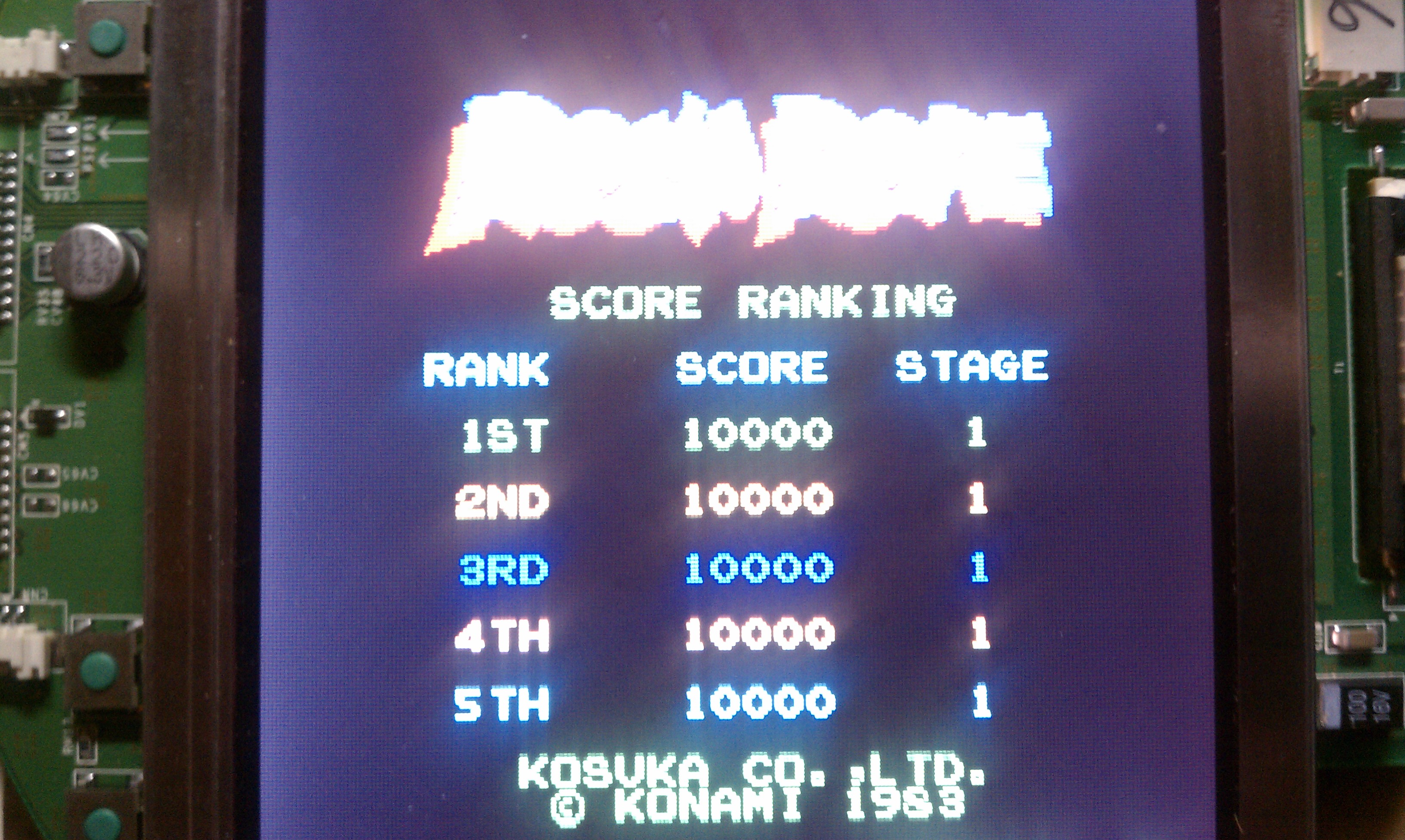
Also, I found out that I have another RnR board, this one with a graphics issue involving the sprites. Should be able to get that one fixed as well, and then I will have two original RnR boards (both with their original serial number stickers on ’em).
OK – this other RnR board just had to have some of its chips cleaned and/or reseated. It is looking good now as well:

Nutshell: Flipped tiles and text, cause was a 74174 at location G15 with a stuck output @ pin 10.
Centipede Cocktails — Cocktail #2
My previous post, about Cocktail #1, clearly documents the “easy one.” This second one is gonna be another story. It has a very dead monitor, and a non-functional board. I have not yet benched the monitor, but it has no neck glow, which is never a good sign.
The board has problems, but at least I know it is not the CPU as I already swapped it, and I know that it is not a power problem on the second Cocktail, because the board has the same behavior in Cocktail #1.
Swapped all socketed chips to no effect — they all work on the other board. Power points seemed right on the board, but I put it into my working cabinet to verify… and while doing so I managed to cross GND with a +5v trace and smoked R30 quite nicely on my AR-II board.
I have replaced it, but am still getting voltages that are too high. Gonna have to hunt other likley suspects…
As far as the board goes, I am gonna have to break out the Fluke 9010 to work on this one… Right after building an adapter for it so I cam power it up on the bench.
The monitor I should know more about once I have it on the bench and take a good look at it while I am capping it (and doing the sync upgrade).
—–
Turns out that this one had a cracked flyback. I ordered a replacement kit (flyback and caps) from The Real Bob Roberts and replaced the flyback (my first flyback replacement!). Have not yet put it back into the game and fired it up, though. Maybe after winter…
Centipede Cocktails — Cocktail #1
Well, I ended up taking two Centipede cocktails off of another local collector as a package deal. Still want that Gorf, though… Will have to come back to that one soon!
But I digress… So I have two Centipede cocktails here. One of them has a dead monitor (and a non-working board, I later discovered), and the other will not sync:
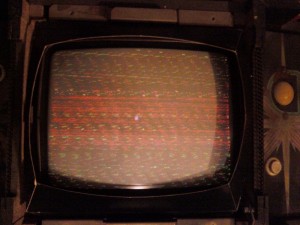
(Note how dirty the control panel is, as well as the color of the button and trackball to compare with another picture later in this post.) Checked the wiring, the connectors, adjustments/controls and nothing would get it right, so I went to capping it. Here is a picture of it half way done on my bench:
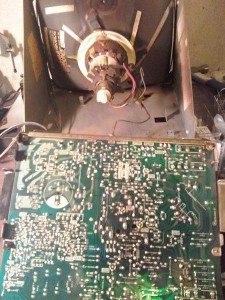
After capping it (and also doing the sync improvement upgrade while I was there), all it took was a few adjustments and the screen came up sharp and clear. This image also shows one of the rebuilt trackballs, which is now running as smooth as when it came out of the crate:
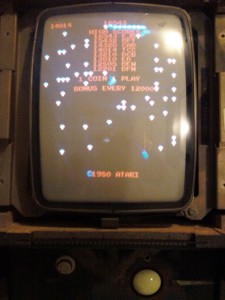
The text looks a bit blurry, but only in the picture. The screen is really sharp! You can also see a new shiny trackball at the bottom too. Next to it is a really dirty button. Here is one of the panels (from the other cocktail, because its panels are in better condition) with a replacement button and a (unmounted) rebuilt trackball after being cleaned up a bit:
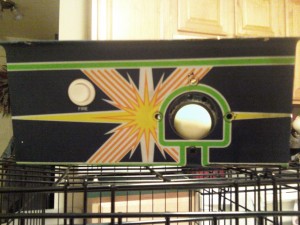
All in all, not bad for about 3 or so hours of work, if I do say so myself. (3 hours for everything, not just cleaning this panel! 🙂
Now, that other cocktail… that one is gonna be a bit harder…
Capping Punch-Out!!
Well, I finally got around to capping the two monitors on my Punch-Out!! game, and let me tell you, it is a serious pain in the ass!
It is bad enough that the Sanyo 20-EZ monitors are pains to cap in the first place, there are even more so when mounted horizontally in a narrow cabinet! Took more than three(!) hours for me to do the first (upper) one. The second one was a bit faster, clocking in at about 1 hour and 45 minutes.
A bit of hard work, to be sure, but the results speak for themselves:
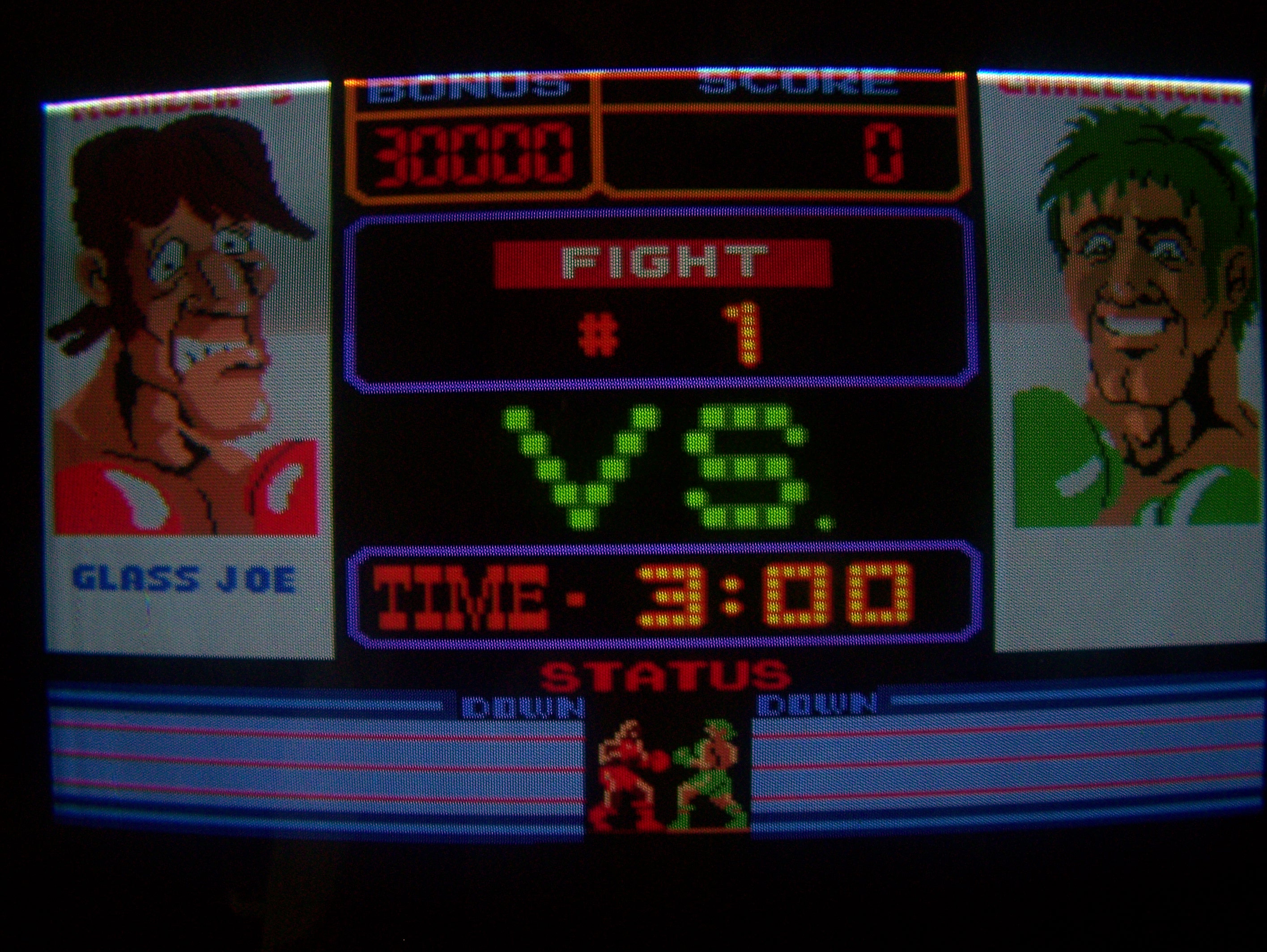
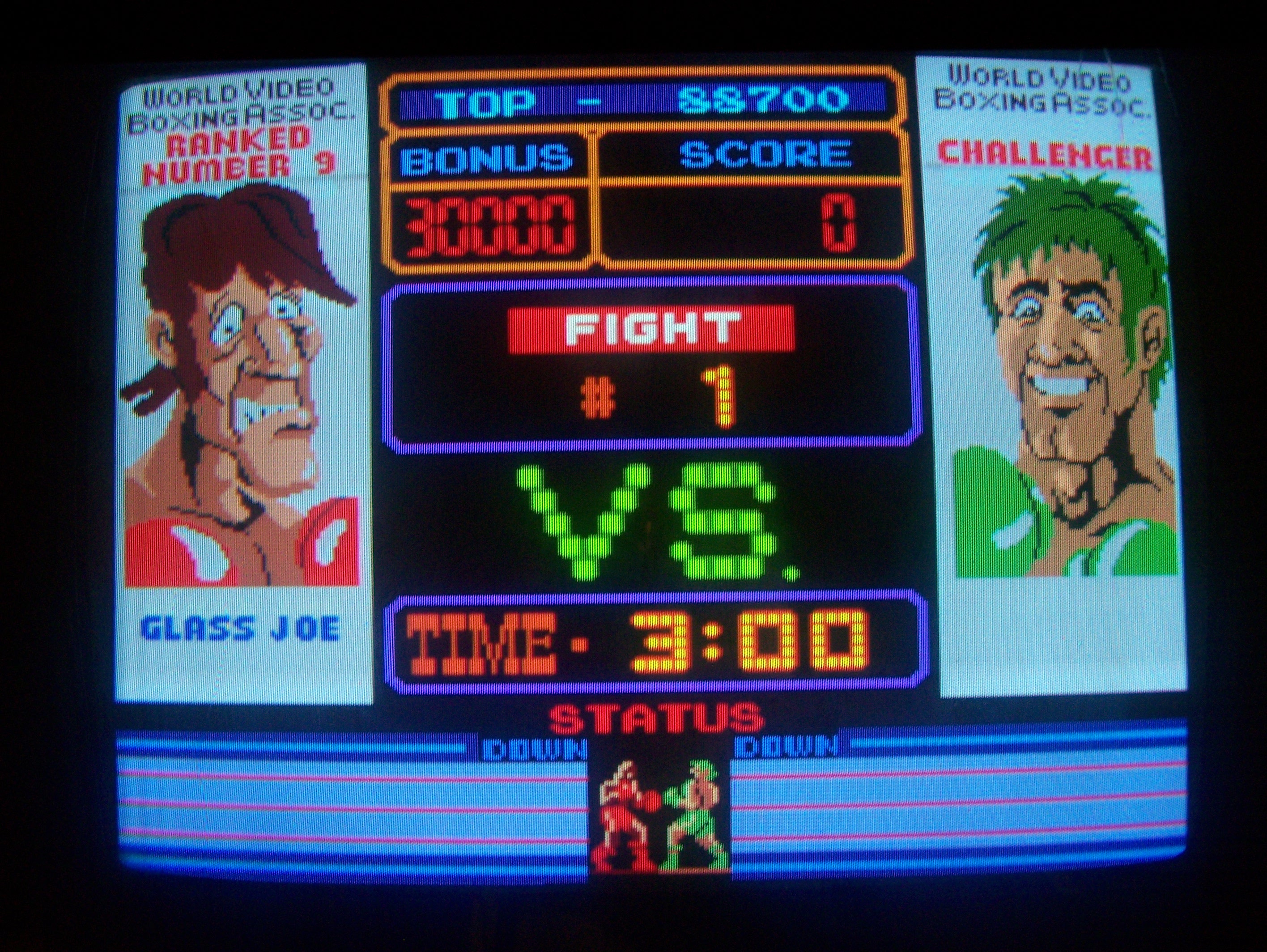
Also, note that there is screen burn from the collapsed line that was there before. This means that the game was in operation for a long time while it needed a cap kit!
While working on the monitor chassis boards, I was never more happy to have purchased a soldering and desoldering station a couple of years ago (shown sitting atop the Punch-Out!!):
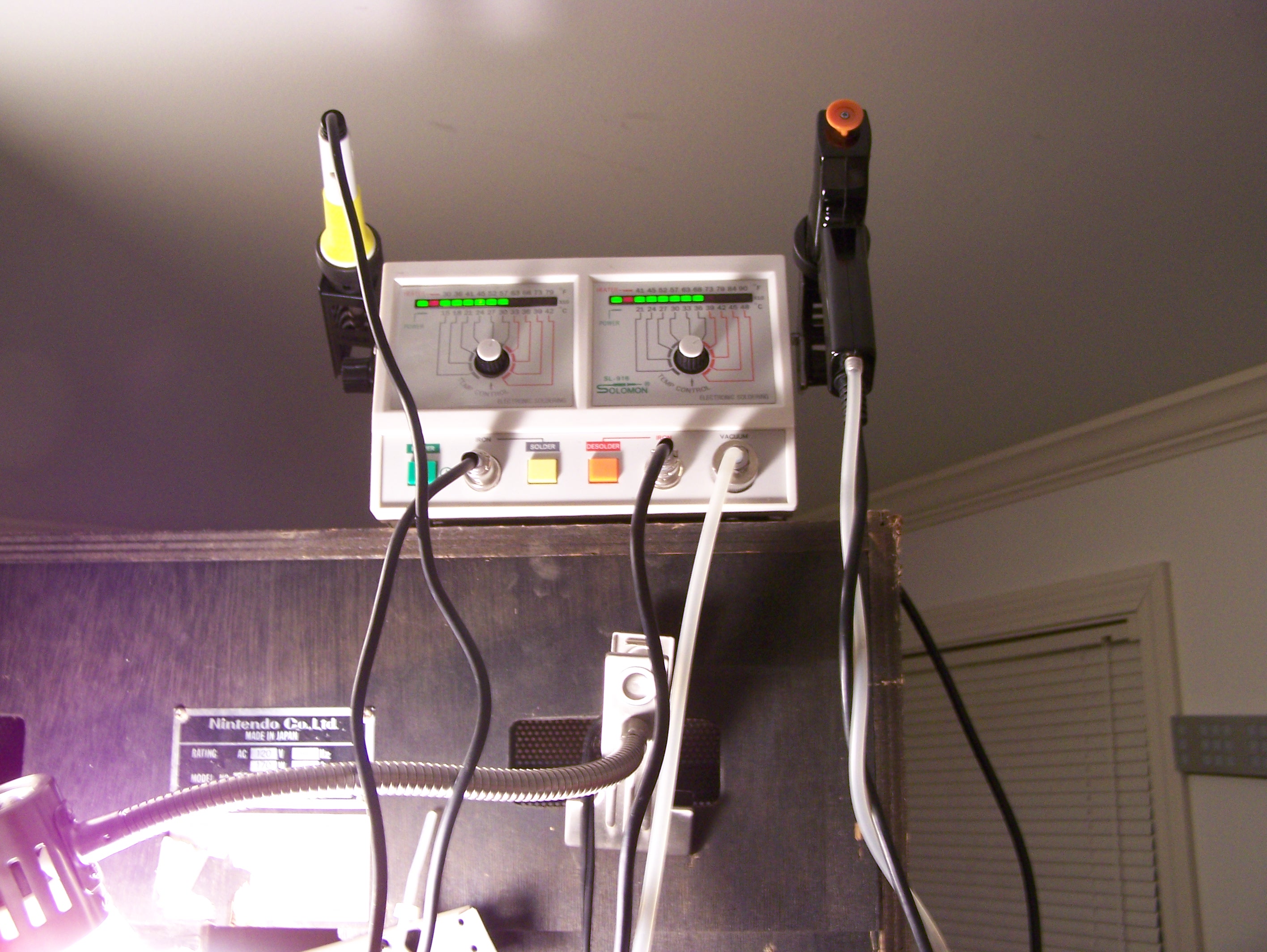
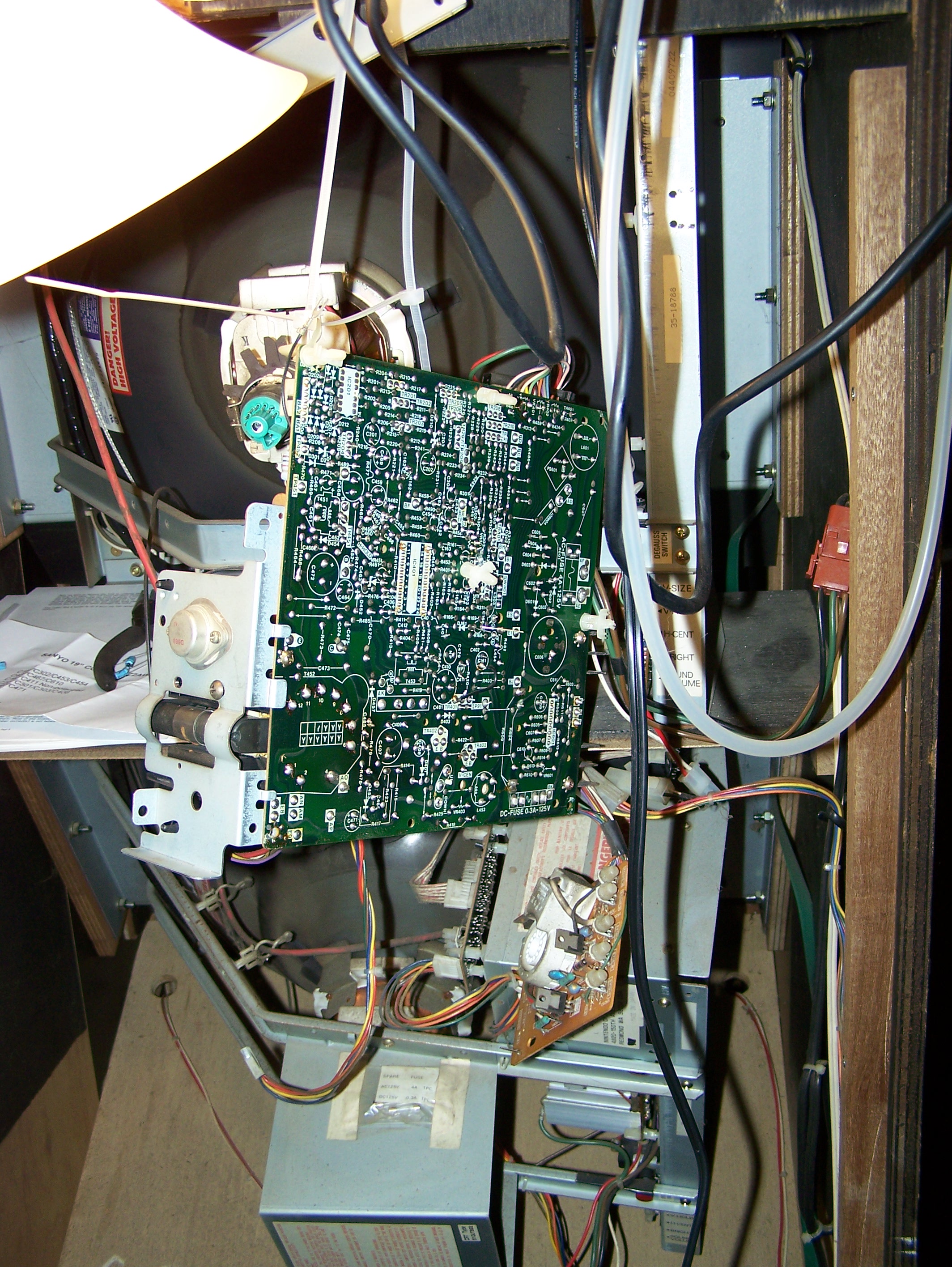
Much thanks go to The Real Bob RobertsTM for the cap kits (I purchased the 20EZ Plus kit, which has 9 additional chassis caps), and to Brien King (no, I did not misspell Brien), which has a step-by-step guide to getting the chassis PCB out of the Sanyo 20-EZ monitor at Arcade Restoration Workshop. I used the document for the first monitor, and tackled the second one from memory.
I also cleaned and changed the spring on the joystick. It is no longer as sticky as it was before thanks to getting all that old dirty grease out of it. However, it is still far too loose for my taste. It is playable, and I have played games in the arcade in far worse condition, but it still would be nice to have it a bit stiffer.
Also replaced the batteries in it so that the high score table works correctly again. Surprisingly, there is not a lot of corrosion in there.
OK – I think it may be ready to sell soon…!
Sprint 2 – Stiff Steering and Hard Shifting
Problem: Stiff spinning steering modules and hard shifting between gears
(Quick little story – while bringing this beast into its location, I fell and got pinned under it for a few minutes. It is amazing how much having your chest compressed effects your ability to call out for help! 🙂
OK – onto the next issue… Its steering wheels were pretty stiff, and if you tried to give them a good hard spin they would come to a halt within a couple of turns. Removing and disassembling them was easy. Turns out the problem was that the old grease in them had coagulated/thickened so that it was about as viscous and sticky as cold honey!
Getting the grease out of the barrel and off of the shaft and sleeves literally took ~10 minutes (for each module) with some rubbing alcohol, elbow grease and rags. I had a friend helping me (Sean) and we each tackled one sterring wheel each.
After getting that old gunk out, a quick application of some light lithium grease on everything solves that problem – the wheels will now spin for at least 10 turns easily.
For the shifter modules, I just applied some powered graphite to the shifter “ball” at the opening of the shifter and after a few shifts to get it all around, the shifts are much easier now.
Solution: Cleaned and lubricated the steering modules, lubricated the shifter modules.
Note: One of the steering modules has a broken shaft/cone, which caused the wheel to be off-center, and it was being held in place strictly by the force of the retaining bolt that goes through the entire assembly. I managed to get it a bit straighter than it was before, but it still is broken internally. Not sure if I want to go through sanding down the two halves to try to get them melded or epoxied together – I am afraid of shortening the cone too much and causing problems. The wheel works and the game is playable, so I might just leave it as it is.
Punch-Out vertical foldover/overdraw
The Punch-out that I recently obtained has a monitor issue (a monitors issue, really). Both displays are bring drawn starting ~2″ from the bottom of the monitor, and the upper few inches are being overdrawn on the same horizontal plane.
In other words, the beam is scanning left/right correctly but is starting too low and is not going high enough (vertically) to complete drawing the image correctly – the beam stops going up and keeps trying to draw the rest of the screen on the same horizontal line, causing a higher-intensity line to be seen (images below, apologies for their quality – I guess I shoulda taken off the Plexiglas first).
The overdraw is visible in the image, but it is not obvious from the images that the bottom of the image is ~2″ higher than it should be. The overdraw looks like a classic capacitor problem to me, although I admit that I am not that familiar with the “starting too high” problem and I am guessing that the two are related. At least, the two things being related kinda makes sense in my mind…
I have cap kits from The Real Bob RobertsTM (highly recommended for all kinds of arcade-related parts, BTW!) for the monitors and will be capping them shortly.
More to follow…
Sprint 2
Problem: Static garbage on screen
Purchased a Sprint 2 in non-working condition. Saw a picture of it, monitor worked – it showing what appeared to be static garbage on it. Got it home and confirmed that yes, it is showing static garbage (first image below). Turning it off for a couple of seconds and then back on again keeps pretty much the same garbage display, but sometimes gets some sounds out of it (engine and/or screeching sounds). Moving the self-test switch does nothing. First suspect that CPU is not running, because the screen is static (i.e. not changing while the game is on).
After checking the usual suspects (voltages, loose wires, harness/wire burns because this is an older Atari game…), I yank the CPU to see if I get the same results (to narrow it down to the CPU). This causes a different effect, a screen filled with a single character and I get sound, so I presume for now that the CPU is working and the problem lies elsewhere.
Punch-Out
Problem: Dead
Purchased a Punch-Out in dead condition. Got it home, still dead. Rocking the game and/or whacking the sides a bit got a brief flash of light on it so I went in and reconnected all connectors. Game then came up right after that.
A little adjustment to the micro-switch arms and the game is playing nicely. Still need to rebuild the joystick as it is stiff and sticks a bit.
Solution: Re-tighten/reattach all (power?) connectors
Goindol
Problem: Board boots but does not complete POST. Halts with some on screen garbage displaying BAD ROM 5 on more often than not. ROMs were clearly marked on the board, so I yanked ROM 5, read it and ran it through ROMCMP. It came up as unknown. Sounds bad to me!
Located a replacement ROM image and burned to a new EPROM (uh, after finding a replacement EPROM that would erase and burn correctly – that took a good hour and change). Verified the new EPROM was correct, loaded it into the game and…
BAD ROM 5
OK… I pull the board and start a visual inspection. Notice a section of the board with about 5 or 6 scratched traces. Two of them are broken (no continuity). Jumped them with some wire-wrap wire and the board comes right up! I do not yet have a way to test inputs yet, though…
Solution: Reburned ROM 5, jumped two broken traces. (Inputs unknown.)
Unknown Atari Kangaroo Board
I bought two or three sets of unknown/untested/bad boards sometime last year. I have recently started going through them to determine the severity of their problem(s). (This is taking a surprisingly long amount of time due to the time it takes to create a JAMMA adapters for each unique interface! :/ )
Anyhoo, I came across a complete, intact Kangaroo board last weekend! After creating a minimal adapter (Power and Video), the board came right up! I tried its self-test and it passed. After watching the attract mode for a little bit (~30 seconds), the game started to show some visual artifacts on the RHS of the screen. They were horizontal blurbs that looked like multicolor static. However, each of the blurbs, while in a random vertical location, were identical.
Cook Race (bootleg Burgertime)
Some sprites are missing, but still in the game. For example, when you throw the Pepper, it is not drawn on the screen, but it still stuns the bad guys. One or two of the bad guys are also invisible, so Peter Pepper can effectively get killed by nothing!
Game does not draw garbage where these graphics/sprites should be, they are just never drawn at all, and they do not disrupt the background graphics (i.e. they are completely transparent) so I do not think that it is a ROM or RAM problem.
Not knowing too much about this kind of problem, my first guess is that the specific sprite(s) are not getting their data placed in the appropriate spot when it comes time to draw the required sprites. For example, they are not getting selected by a latch that determines if it should draw the sprite’s colors, or draw the background (in transparent parts of the sprite). So into the schematics I go…
Solution: None yet.
Update #1: Well, fat lot of good that did. I could only find schematics for Burgertime, and not even the cassette version (which the Cook Race hardware seems to follow) for that matter. This one is starting to collect dust on the shelf.
Update #2: David Widel said on his web page (www.widel.com) that he was looking for a Cook Race board. I contacted him about it and he said that he would be interested in it so I gave it to him. Better to further the arcade/multigame cause than to have it sitting on my shelf collecting dust.
Dig-Dug (“Has a ROM Error”)
Purchased described as “Has a ROM error“. Started by creating a JAMMA adapter, and then read the EPROM at 2E, it was not found under Romident, burned and installed a replacement. No change. Removed and read all ROMs in row/column 2, and all but one of them failed to be identified by Romident, burned and installed 5 more replacements, working! Still have to wire up an amplifier to correctly test the sound, but looks good so far.
[07/30/03] I finally found the brain cell that got me to realize that I could use my inductive listener (a telecom tool, often used with a tone tracer) to test the sound. It works!
Solution: Replaced bad ROMs
(Recently, the board is starting to develop an intermittent problem with a bad socket. I am going to replace it as the first use of my soon-to-be-here combination soldering/desoldering station.)
Gyruss (Konami, bootleg)
Boots and passes self-test, but immediately coins itself up and starts playing itself(!), although not too well.
Well, it looks like some of the inputs are firing rapidly and randomly. Grounding one of the enable pins on one of the 74LS253s seems to make it settle down for a few seconds, so I will try playing with it.
[07/30/03] Update #1: OK, it looks like one of the outputs (za) is always low on the 74LS253, regardless of its inputs. Will try swapping it out.
Solution: None yet.
Kicker (Konami)
Random garbage (no sprites) and occasional random sounds, reboots randomly. Clock looks good, CPU and bus address and data lines have what appears to be otherwise normal activity (i.e. nothing appears stuck or floating). Pulled EPROMs and Romidented them; Romident does not identify all but 2 of them, and the two that are identified are not identified as Kicker ROMs!
OK, so I pull the EPROM archive for Kicker, and match them up that way. Three of them match up, four do not. Hmmm… One of the EPROMs does not erase(!). Going digging for a replacement…
Solution: None yet.
Galaxian – “Dead”
Purchased described as “dead”. Started by creating a JAMMA adapter (I hate creating adapters, it is tedious work). Well, the description was correct – she is dead alright: screen has static garbage and required some tweaking to sync correctly on my test bench monitor.
Watchdog is barking, disabling it has no effect on the screen’s contents. Board already had some previous work done in it, solder-side contains more than 20 jumps to connect some RAMs back onto the bus. The Parts side shows the missing/removed/blown traces being jumped.
Started by checking the daughterboard, seems OK. Next I remove, socket and replace the 74LS245s on the board because word has it that they tend to be the cause of most problems, the Galaxian Trouble Shooting Logic Board manuals lists similar symptoms connected to those chips, and the Fluke 9010 troubleshooter says that the address lines are tied. Other than that, I cannot come up with a good way to check them! 🙂
Gotta wait for some replacement sockets and chips to come in…
PAC-MAN (Midway, single board)
Board 1
Flashing “1” in corner of screen. Took a look at the Pac-Man troubleshoot by picture guide and that pointed me to “4R video RAM bad”. Swapped it, no good!
Tried swapping other RAMs, no change either. Started pulling all socketed chips and found a bent pin on the ROM at 6E! straightened it, and reinserted, Pac lives once more.
That will teach me to try the simple checks/fixes before the more complex ones…
Solution: Fixed bent pin on a ROM chip.
Board 2
Game would boot normally, but would then start getting random lines/glitches through the screen after running for a couple of minutes; they did not otherwise effect gameplay. Immediately suspect video RAMs, start hitting ’em with the freeze spray and sure enough, got a bad one. Replaced it, and all is well!
Solution: Replaced bad RAM chip.
